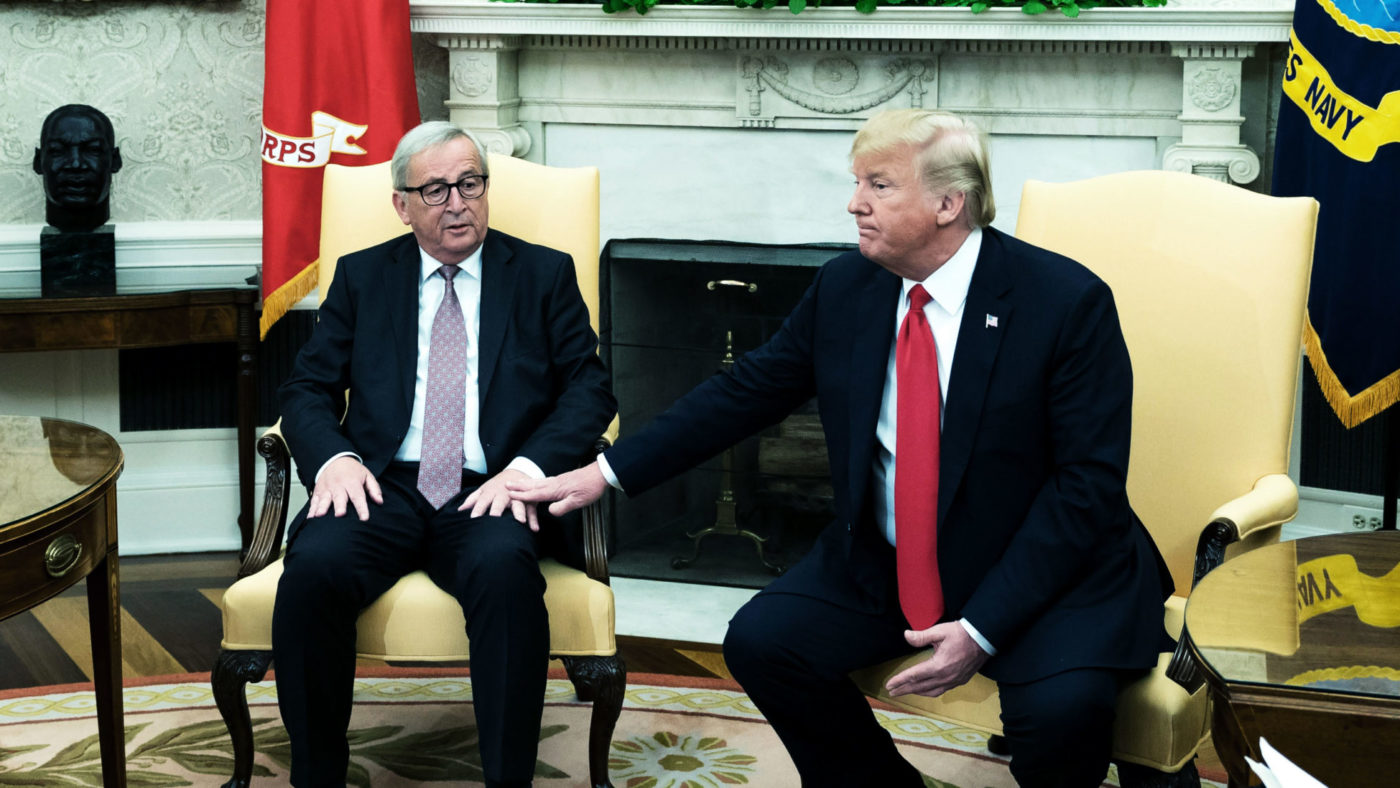Donald Trump’s proudest moment after yesterday’s meeting with Jean-Claude Juncker seemed to be when the US president said the EU would soon be buying “a lot of soybeans” from the United States.
The head-to-head in Washington DC followed months of puerile chest-beating over trade, which degenerated into Trump last week describing a group of longstanding US allies as a “foe”. As so often with Trump, when it came to a face to face meeting, the tone was altogether more civilised and friendly than his Twitter rants and soundbite-heavy press conferences.
But the fact that soybeans were top of the agenda suggests Trump and Juncker were only paying lip service to the “close friendship” between the two federal powers either side of the Atlantic. When it came to other concrete measures, details were depressingly thin on the ground.
The soybeans were enough to satisfy Mr Trump, though. The US president had been under fire over his protectionist policies in the days leading up to yesterday’s summit. With a damaging trade war with China underway, he recently tweeted that “tariffs are the greatest”.
He presumably failed to spot the irony of then announcing a $12 billion compensation package for farmers hit by the trade war he has instigated. For anyone wondering what the costs of such a clash, Trump has provided an instant and arresting example.
His pro-trade colleagues in the Republican Party were dismayed, with one arguing rather theatrically that the US “is becoming more and more like a Soviet type of economy”.
And this is where those soybeans come in. A few weeks ago, responding to Trump’s madcap steel tariffs, China slapped a 25 per cent levy on American soybeans. It’s a move with serious consequences, given that US farmers export 37.5 million tons a year of the stuff to China, versus a mere five million to EU countries. The University of Tennessee predicted that China’s tariffs would lead to a fall in shipments worth $4.5bn.
It’s not just American farmers who will suffer, but Trump himself when it comes to the 2020 presidential election. After all, soybean production is concentrated in the Midwest and the area surrounding the Mississippi River. Aside from Illinois and Minnesota, all the states where soybean is a major crop voted for Trump in 2016. It’s hard to imagine those voters falling behind Trump again if their livelihoods have been threatened in the name of “protecting American workers and security”.
Cometh the hour, cometh Jean-Claude Juncker. It isn’t quite clear just how many soybeans Brussels intends to buy from the US, but if Trump understood Juncker correctly, it will be “a lot,” and it will start “immediately” – and that’s before we get to the “vast amounts of liquefied natural gas” heading east across the Atlantic.
Even less clear is who will actually buy these beans, considering there is little reason why Europeans should have developed an intense desire for soybeans in the course of the last day or so, even if veganism is going from strength to strength. So far it only says that “the EU” will be on the purchasers’ side. But despite the fuzzy details, this is still a big and much-needed strategic win for Donald Trump.
What did Juncker get in return? Very little, as it turns out. In his opinion, the biggest win was that the US side had “agreed to not increase tariffs on cars as long as we are on negotiating terms”. Trump had originally planned to increase the current 2.5 per cent tariff on European cars to 20 per cent — far in excess of the EU’s ten per cent tariff on American cars.
That threat had raised the alarm in Europe, with Angela Merkels’s government in particular lobbying the Commission to do everything in its power to prevent what would have been a catastrophe for the German car industry. Thankfully for them, those tariffs — which it must be noted were never actually in place — are gone.
Unfortunately, all of Trump’s other tariffs are still in place, including the ludicrous 25 per cent charge on steel and aluminium imports. So too are the EU’s retaliatory levies on some $3.3 billion of American products such as Harley Davidson motorcycles, Kentucky bourbon and Levi’s jeans. And the EU’s 10 per cent tariff on American cars remains, as does the much less onerous American levy.
So, for all the chummy discussions, pretty much everything remains as it is the same, except that Trump has been generous enough to forestall hiking car tariffs and the EU seems committed to buying a lot more soybeans and natural gas than it actually needs.
And what of the idea that free trade is back on the agenda? Well, for all the pledges “to work together toward zero tariffs, zero non-tariff barriers, and zero subsidies on non-auto industrial goods”, there is precious little concrete action to back up the warm words.
It is all a far cry from the positive noises the day before the meeting, when Trump suggested that “all tariffs, barriers, and subsidies” could simply be abolished, and EU Budget Commissioner Günter Oettinger agreed this option might be on the table.
This is not to say that the results of yesterday’s meeting aren’t promising. Friendly dialogue is always better than a full-fledged trade war, and it is good to see that further escalation is off the agenda for the time being. But it would be an exaggeration to suggest this meeting was a big step on the path to transatlantic free trade.
All the tariffs that were in place before yesterday are still in place today; the only ones gone are those Trump had threatened to implement. For all their soundbites about cooperation, we are still a long way from the tariff-free trade that is in everyone’s interests. A politician that was really committed to free trade would abolish all their tariffs now. Unfortunately, neither Juncker or Trump are that politician.


